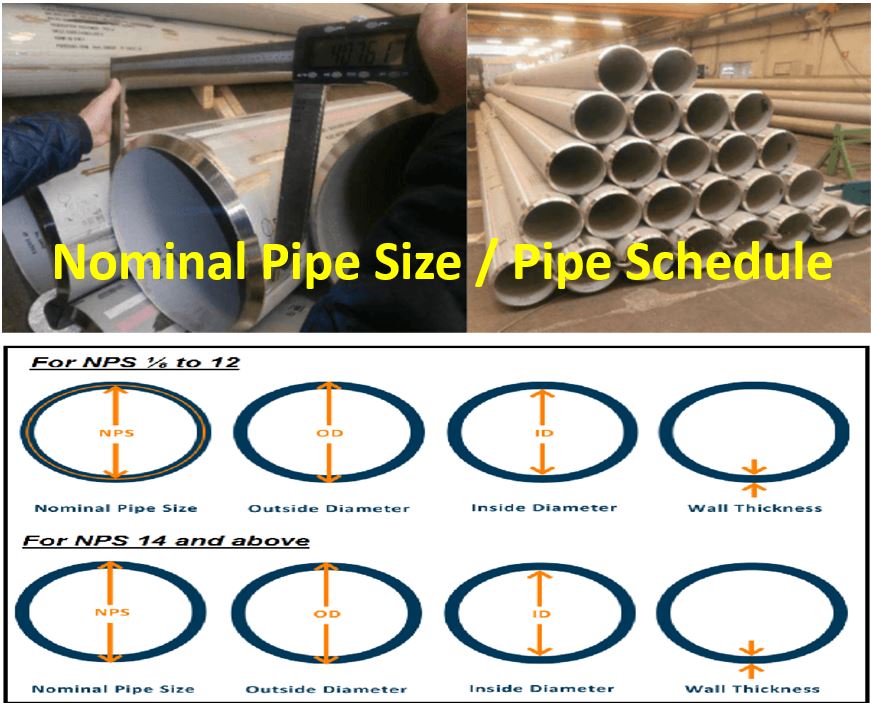What is Nominal Pipe Size?
Nominal Pipe Size (NPS) is a North American set of standard sizes for pipes used for high or low pressures and temperatures. The name NPS is based on the earlier “Iron Pipe Size” (IPS) system.
That IPS system was established to designate the pipe size. The size represented the approximate inside diameter of the pipe in inches. An IPS 6″ pipe is one whose inside diameter is approximately 6 inches. Users started to call the pipe as 2inch, 4inch, 6inch pipe and so on. To begin, each pipe size was produced to have one thickness, which later was termed as standard (STD) or standard weight (STD.WT.). The outside diameter of the pipe was standardized.
As the industrial requirements handling higher pressure fluids, pipes were manufactured with thicker walls, which has become known as an extra strong (XS) or extra heavy (XH). The higher pressure requirements increased further, with thicker wall pipes. Accordingly, pipes were made with double extra strong (XXS) or double extra heavy (XXH) walls, while the standardized outside diameters are unchanged. Note that on this website only terms XS & XXS are used.
Pipe Schedule
So, at the IPS time only three walltickness were in use. In March 1927, the American Standards Association surveyed industry and created a system that designated wall thicknesses based on smaller steps between sizes. The designation known as nominal pipe size replaced iron pipe size, and the term schedule (SCH) was invented to specify the nominal wall thickness of pipe. By adding schedule numbers to the IPS standards, today we know a range of wall thicknesses, namely:
SCH 5, 5S, 10, 10S, 20, 30, 40, 40S, 60, 80, 80S, 100, 120, 140, 160, STD, XS AND XXS.
Nominal pipe size (NPS) is a dimensionless designator of pipe size. It indicates standard pipe size when followed by the specific size designation number without an inch symbol. For example, NPS 6 indicates a pipe whose outside diameter is 168.3 mm.
The NPS is very loosely related to the inside diameter in inches, and NPS 12 and smaller pipe has outside diameter greater than the size designator. For NPS 14 and larger, the NPS is equal to 14inch.
For a given NPS, the outside diameter stays constant and the wall thickness increases with larger schedule number. The inside diameter will depend upon the pipe wall thickness specified by the schedule number.
SUMMARY:
Pipe size is specified with two non-dimensional numbers,
- nominal pipe size (NPS)
- schedule number (SCH)
and the relationship between these numbers determine the inside diameter of a pipe.
Stainless Steel Pipe dimensions determined by ASME B36.19 covering the outside diameter and the Schedule wall thickness. Note that stainless wall thicknesses to ASME B36.19 all have an “S” suffix. Sizes without an “S” suffix are to ASME B36.10 which is intended for carbon steel pipes.
The International Standards Organization (ISO) also employs a system with a dimensionless designator.
Diameter nominal (DN) is used in the metric unit system. It indicates standard pipe size when followed by the specific size designation number without a millimeter symbol. For example, DN 80 is the equivalent designation of NPS 3. Below a table with equivalents for NPS and DN pipe sizes.
| NPS | 1/2 | 3/4 | 1 | 1.1/4 | 1.1/2 | 2 | 2.1/2 | 3 | 3.1/2 | 4 |
| DN | 15 | 20 | 25 | 32 | 40 | 50 | 65 | 80 | 90 | 100 |
Note: For NPS ≥ 4, the related DN = 25 multiplied by the NPS number.
Example :
Article Source : wermac
ImageSource : wermac ; theprocesspiping; rolledalloys; commercial-industrial-supply

